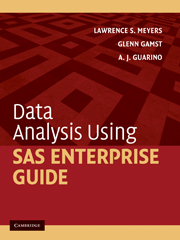Book contents
- Frontmatter
- Contents
- Preface
- Acknowledgments
- I Introducing SAS Enterprise Guide
- II Performing Analyses and Viewing Output
- III Manipulating Data
- IV Describing Data
- V Score Distribution Assumptions
- VI Correlation and Prediction
- VII Comparing Means: The t Test
- VIII Comparing Means: ANOVA
- 23 One-Way Between-Subjects ANOVA
- 24 Two-Way Between-Subjects Design
- 25 One-Way Within-Subjects ANOVA
- 26 Two-Way Mixed ANOVA Design
- IX Nonparametric Procedures
- X Advanced ANOVA Techniques
- XI Analysis of Structure
- References
- Author Index
- Subject Index
24 - Two-Way Between-Subjects Design
Published online by Cambridge University Press: 05 June 2012
- Frontmatter
- Contents
- Preface
- Acknowledgments
- I Introducing SAS Enterprise Guide
- II Performing Analyses and Viewing Output
- III Manipulating Data
- IV Describing Data
- V Score Distribution Assumptions
- VI Correlation and Prediction
- VII Comparing Means: The t Test
- VIII Comparing Means: ANOVA
- 23 One-Way Between-Subjects ANOVA
- 24 Two-Way Between-Subjects Design
- 25 One-Way Within-Subjects ANOVA
- 26 Two-Way Mixed ANOVA Design
- IX Nonparametric Procedures
- X Advanced ANOVA Techniques
- XI Analysis of Structure
- References
- Author Index
- Subject Index
Summary
Overview
In this chapter we discuss how to perform a 2 × 2 between-subjects ANOVA. The advantage of combining two independent variables into a single design is that we not only evaluate the differences between the levels of each variable separately, called main effects, but we also evaluate the unique combinations of the levels of the variables, called an interaction effect. Detailed explanations of interaction effects can be found in a variety of sources (e.g., Agresti & Finlay, 2009; Gamst et al., 2008; Runyon et al., 2000). Here is a very brief one:
A main effect addresses the differences between the means of the levels of a single independent variable. In factorial designs, the main effect means are averages across all of the other independent variables in the study. In Figure 24.1, the main effect of A is evaluated by comparing the mean of a1 with the mean of a2, and the main effect of B is evaluated by comparing the mean of b1 with the mean of b2.
An interaction effect of A and B (the A × B interaction) addresses the differences in patterns of means between the levels of one independent variable across the levels of the other independent variable. For example, we contrast the pattern of a1b1 and a1b2 with the pattern of a2b1 and a2b2. If those patterns differed, that is, if the patterns did not reflect a parallel relationship, then we would have a significant interaction effect; if those patterns were the same (if they were parallel), then there would be no significant interaction effect.
- Type
- Chapter
- Information
- Data Analysis Using SAS Enterprise Guide , pp. 223 - 237Publisher: Cambridge University PressPrint publication year: 2009



